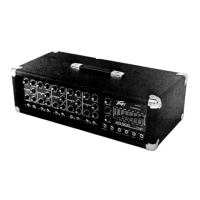
Do you have a question about the Peavey XR-500 and is the answer not in the manual?
| Type | Powered Mixer |
|---|---|
| Equalization | 3-band EQ per channel |
| Weight | 27 lbs (12.2 kg) |
| Input Impedance | 10k Ohms |
| Output Impedance | 4 Ohms |
| Effects | Reverb |
| Inputs | XLR and 1/4" on each channel |
| Outputs | Main, Monitor |
| Frequency Response | 20 Hz - 20 kHz |
Overview of the XR-500's independent channels, equalization, and effects.
Explains the exclusive DDT compression circuitry for headroom and distortion prevention.
Details the power amp's TO-3 devices, heatsink, and power supply design.
Describes the dual input jacks for flexible microphone matching and overload protection.
Adjusts input preamplifier gain for optimum dynamic range and low noise.
Independent level adjustment for the monitor mix, feeding the monitor buss.
Active shelving EQ for 15 dB boost/cut, affecting tonal balance and feedback control.
Boosts or cuts low frequencies; clockwise for boost, counter-clockwise for cut.
Boosts or cuts high frequencies; clockwise for boost, counter-clockwise for cut.
Adjusts signal level to the effects bus for internal reverb and external effects output.
Controls master level, monitor, reverb return, and graphic EQ for system management.
Provides access to the main mixing buss for external devices.
Delivers output signal from the effects buss to drive line-level devices.
Provides a signal for an external monitor system.
Delivers output from the main mixing buss.
Allows patching into the internal graphic equalizer/power amp.
Location and importance of the fuse for equipment protection and warranty.
Adjusts the main mixing buss gain, affecting main output and amp input.
Controls the gain of the monitor mixing buss, determining monitor output level.
Adjusts the amount of delayed signal mixed back into the main mix buss.
Details using the master graphic EQ for room equalization, feedback control, and tone shaping.
Warns about potential power amplifier overload from excessive EQ boosts.
Provides a procedure for using the graphic equalizer to suppress feedback.
Indicates when the electrical supply is switched on and delivering power.
Explains the DDT compression and its LED indicator for maximizing amp performance.
Designed for using auxiliary accessories, mixers, and power amps.
Input jack for an optional remote reverb cutoff pedal.
Explains the three-position power switch and selecting the correct position for low hum.
Importance of the three-wire line cord with proper grounding for safety and noise reduction.
Details the 1/4" speaker output jacks, their parallel wiring, and impedance considerations.
Features on the rear panel for storing the mains cable during travel.
Emphasizes protecting hearing from high noise levels to prevent permanent loss.
Lists important cautions regarding water, heat, ventilation, and servicing.
Details precautions related to power cords, grounding, and potential shock hazards.
Provides detailed technical specifications for channels, inputs, outputs, and power.
